Prepare to have your perception of Arabica coffee transformed as you delve into the depths of its fascinating world.
From its mysterious origins to its intricate cultivation practices, Arabica coffee holds a wealth of surprising facts waiting to be unveiled.
Discover the hidden secrets behind this beloved brew and unlock a new appreciation for the complexities that lie within each cup of Arabica coffee.
What Secrets Does Arabica Coffee Hide?
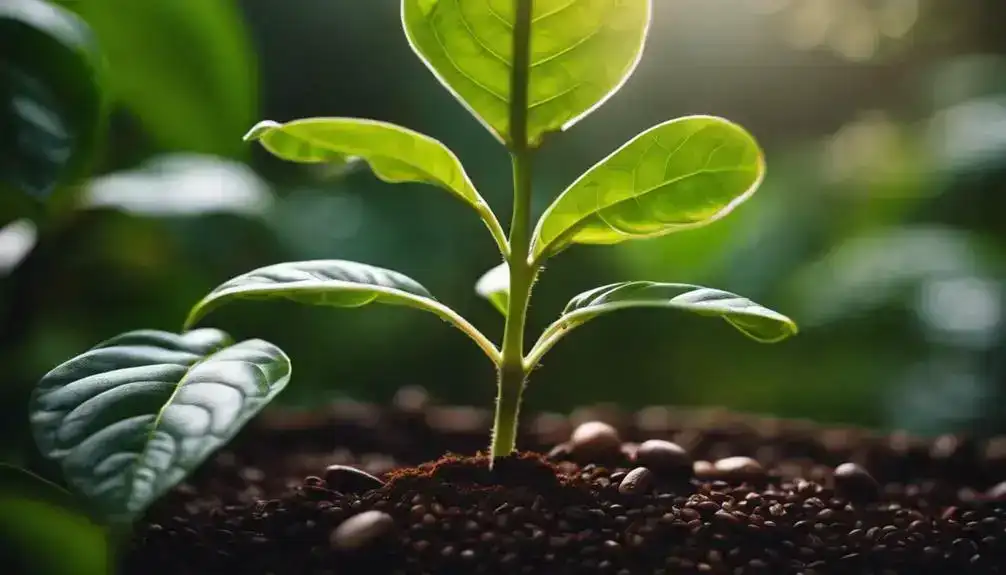
Arabica coffee holds a captivating history that goes beyond just being a morning pick-me-up. Have you ever wondered how this humble bean from Ethiopia rose to become a global favorite in the world of coffee?
Discover the intriguing story behind Arabica’s journey to dominance and why it continues to be cherished by coffee enthusiasts worldwide.
How Did Arabica Become More Than Just a Coffee Bean?
Unveiling the hidden allure of Arabica coffee reveals a world of complexity and flavor waiting to be explored. Arabica has evolved beyond just a coffee bean; it has become a symbol of refinement and quality in the coffee industry.
Let’s delve into the secrets that Arabica coffee hides:
| Hidden Secret | Description | Impact |
|---|---|---|
| Unique Flavor Profiles | Arabica beans offer a wide range of flavors from fruity and floral to nutty and chocolatey. | Provides a diverse tasting experience for coffee enthusiasts. |
| High Altitude Growth | Arabica thrives in high altitudes, developing more complex flavors due to the slower maturation process. | Ensures a more refined and superior coffee quality. |
| Sustainable Farming Practices | Many Arabica farms practice sustainable methods, promoting environmental and social responsibility. | Supports ethical coffee production and preserves ecosystems. |
What’s the Story Behind Arabica’s Journey from Ethiopia to Global Domination?
From its humble origins in Ethiopia, Arabica coffee embarked on a remarkable journey towards global domination, shrouded in intriguing secrets waiting to be uncovered.
Arabica’s story is one of mystery and intrigue, as it spread across continents, captivating the taste buds of millions.
Let’s delve into the secrets that Arabica coffee hides, revealing the hidden gems of its origins.
| Arabica Coffee Secrets | Discoveries |
|---|---|
| Ancient Roots | Arabica’s cultivation dates back to 9th century Ethiopia, where it was first discovered. |
| Global Expansion | Arabica traveled from Ethiopia to Yemen, then to the rest of the world, captivating coffee enthusiasts everywhere. |
| Flavor Diversity | Arabica boasts a rich flavor profile with hints of fruit, chocolate, and floral notes, making it a favorite among coffee connoisseurs. |
| Sustainability | Arabica’s journey emphasizes sustainable farming practices, ensuring its legacy for future generations. |
| Culinary Versatility | Arabica’s beans are not only for brewing coffee but are also used in desserts, sauces, and even savory dishes, showcasing its culinary flexibility. |
What Lies Beneath the Surface of Arabica Coffee?
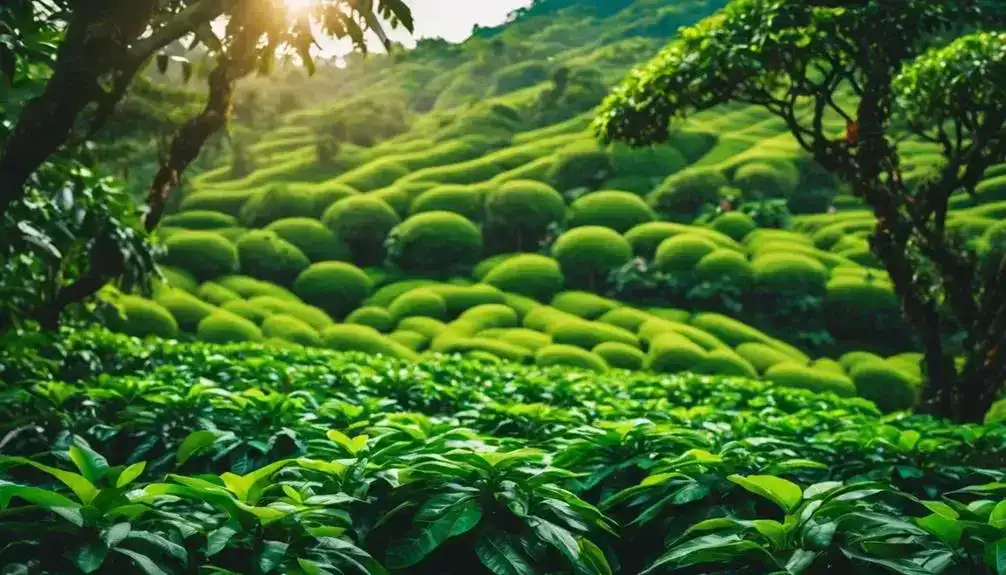
As you sip your favorite Arabica coffee, have you ever wondered about the hidden aspects of the Arabica coffee plant that give it its unique flavors?
Beyond the surface, lie untold flavor profiles waiting to be discovered in each cup of Arabica coffee you enjoy.
What Are the Hidden Aspects of the Arabica Coffee Plant?
When exploring the hidden aspects of the Arabica coffee plant, you might be intrigued by what lies beneath the surface. The Arabica coffee tree’s small size belies its mighty impact on the coffee industry.
Additionally, the Arabica flowers hold the title of nature’s best-kept secret, boasting a unique beauty and aroma that captivates all who encounter them.
| Hidden Aspect | Description |
|---|---|
| What Makes the Arabica Coffee Tree Small yet Mighty? | Explore the surprising power packed into this modest plant. |
| Why Are Arabica Flowers Considered Nature’s Best-Kept Secret? | Unveil the beauty and fragrance of these secret blooms. |
What Makes the Arabica Coffee Tree Small yet Mighty?
Although petite in size, the Arabica coffee tree packs a powerful punch with its hidden attributes that contribute to its remarkable stature in the coffee world. This plant’s small size belies its incredible impact, with features like deep roots and specialized leaves enhancing its resilience and flavor profile.
Check out the table below to uncover more about the Arabica coffee tree’s hidden strengths.
| Hidden Attribute | Contribution |
|---|---|
| Deep Roots | Enhanced Resilience |
| Specialized Leaves | Improved Flavor Profile |
Why Are Arabica Flowers Considered Nature’s Best-Kept Secret?
Delve into the mysterious allure of Arabica flowers, nature’s best-kept secret within the realm of coffee plants. Arabica flowers captivate with their delicate beauty and sweet fragrance, but their significance goes beyond aesthetics.
Unveil the hidden aspects of Arabica flowers that make them truly exceptional:
- Unique Aroma: Arabica flowers emit a captivating scent that enhances the coffee experience.
- Pollination Process: Intricate pollination mechanisms ensure the propagation of these exquisite flowers.
- Flavor Development: The flowers play a vital role in shaping the nuanced flavors of Arabica coffee beans.
- Botanical Resilience: Arabica flowers showcase remarkable adaptability to varying environmental conditions.
- Cultural Significance: These flowers hold deep cultural importance, symbolizing tradition and heritage.
What Are the Untold Flavor Profiles of Arabica Coffee?
Have you ever wondered how diverse the flavor ranges of Arabica coffee truly are? Do you know why Arabica coffee possesses such gentle acidity and low caffeine content?
Let’s explore the untold flavor profiles and characteristics that make Arabica coffee a favorite among coffee enthusiasts.
| Points to Consider: | Discussion Questions: |
|---|---|
| How Diverse Are Arabica’s Flavor Ranges Really? | Have you noticed the wide array of flavors that Arabica coffee can offer? |
| Why Does Arabica Have Such Gentle Acidity? | What factors contribute to the gentle acidity that sets Arabica apart from other coffees? |
| Why Does Arabica Have Low Caffeine Content? | Do you know why Arabica coffee generally contains less caffeine compared to other coffee varieties? |
How Diverse Are Arabica’s Flavor Ranges Really?
Discover the hidden depths of Arabica coffee’s flavor profiles, unveiling a diverse range that captivates the senses and transcends expectations.
Arabica’s flavor ranges from fruity and floral notes to chocolatey and nutty undertones. Each cup offers a unique experience, showcasing hints of caramel, citrus, and even spices.
The intricate balance of acidity and sweetness in Arabica coffee elevates your coffee-drinking ritual to a whole new level.
| Flavor Profiles | Example Notes |
|---|---|
| Fruity | Citrus, Berry |
| Floral | Jasmine, Lavender |
| Chocolatey | Cocoa, Nutella |
| Nutty | Almond, Hazelnut |
Why Does Arabica Have Such Gentle Acidity and Low Caffeine Content?
Unveiling the secrets behind Arabica’s gentle acidity and low caffeine content reveals a unique aspect of this beloved coffee variety.
Arabica’s characteristics are shaped by various factors, such as the altitude of cultivation, climate conditions, soil composition, plant genetics, and harvesting and processing techniques.
These elements work together to create Arabica’s distinctive flavor profile, known for its smooth acidity and lower caffeine content.
What Magic Lies Behind Growing Arabica Coffee?
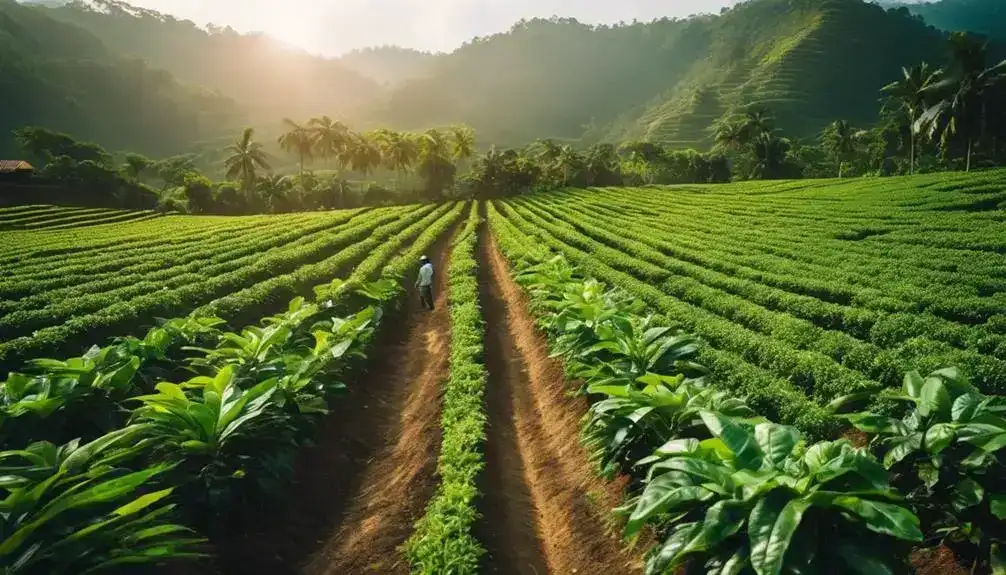
You wonder what makes Arabica coffee cultivation so enchanting.
Let’s explore the essential conditions that nurture this magical bean.
From planting to harvesting, discover the captivating journey from seed to your morning Arabica brew.
What Conditions Are Absolutely Necessary for Arabica Coffee to Grow?
To grow Arabica coffee successfully, you must ensure three key conditions: the right altitude, suitable climate, and proper care.
The altitude affects the taste profile, climate plays a crucial role in the bean’s development, and attentive cultivation practices are essential for a thriving harvest.
| Altitude | Climate | Care |
|---|---|---|
| Altitude significantly impacts the flavor profile of Arabica coffee. | Climate conditions are vital for the proper development of the coffee beans. | Proper care and cultivation practices are crucial for a successful Arabica coffee harvest. |
How Does Altitude Specifically Transform Arabica Coffee’s Taste?
Altitude plays a crucial role in transforming the taste profile of Arabica coffee, influencing its flavor and quality significantly. The higher the altitude, the more complex and flavorful the coffee beans become.
Here’s a table summarizing the impact of altitude on Arabica coffee:
| Altitude Range | Flavor Profile | Quality Level |
|---|---|---|
| Low (0-2000 ft) | Less acidic, milder | Lower |
| Medium (2000-4000 ft) | Balanced acidity, medium body | Moderate |
| High (4000+ ft) | Bright acidity, complex flavors | Higher |
Why Are Climate Conditions So Crucial for Perfect Arabica Coffee?
In the cultivation of perfect Arabica coffee, climate conditions play a pivotal role in shaping the beans’ flavor and quality. The right mix of temperature, rainfall, and sunlight is essential for Arabica plants to thrive.
Arabica coffee requires a subtropical climate with temperatures between 60-70°F (15-24°C) and consistent rainfall. Without these optimal climate conditions, Arabica beans may not develop their sought-after delicate flavors and aromas.
| Climate Condition | Importance |
|---|---|
| Temperature | Optimal temperatures between 60-70°F (15-24°C) are crucial for Arabica coffee plants. |
| Rainfall | Consistent rainfall is needed to ensure proper growth and development of the beans. |
| Sunlight | Arabica plants require adequate sunlight to photosynthesize and produce flavorful beans. |
| Humidity | Moderate humidity levels are necessary to prevent stress on the plants and ensure quality beans. |
What’s the Complete Journey from Seed to Arabica Coffee Cup?
When it comes to the journey from seed to Arabica coffee cup, you might wonder about the intricate steps involved. What unique cultivation techniques are employed for Arabica? When is the optimal time to harvest Arabica coffee? Here are some key points to consider:
- Planting the Seeds
- Nurturing the Seedlings
- Cultivating the Coffee Trees
- Harvesting the Cherries
- Processing the Beans
What Unique Cultivation Techniques Are Used for Arabica?
To unlock the secrets behind cultivating the exceptional Arabica coffee beans, farmers employ a series of meticulous and innovative techniques that enhance the quality and flavor of each cup.
These methods include shade-grown cultivation, intercropping with banana plants, and organic fertilization. By using these unique practices, farmers can ensure the highest quality beans for your aromatic morning brew.
| Cultivation Techniques | Description | Benefits |
|---|---|---|
| Shade-Grown | Growing coffee under tree canopies | Protects from harsh sunlight, enhances flavors |
| Intercropping with Bananas | Planting bananas alongside coffee plants | Improves soil quality, provides natural shade |
| Organic Fertilization | Using natural compost and manure | Enhances soil health, reduces environmental impact |
When Is the Optimal Time to Harvest Arabica Coffee?
At the peak of ripeness, Arabica coffee beans are meticulously harvested to capture their full flavor potential. The optimal time to harvest Arabica coffee is a crucial stage in ensuring top quality beans.
Here are key points to consider when harvesting Arabica coffee:
- Selective picking of ripe cherries
- Hand harvesting for precision
- Timing based on the color of the cherries
- Avoiding overripe or underripe cherries
- Harvesting in the early morning for freshness and flavor
How Has Arabica Coffee Impacted the Globe?
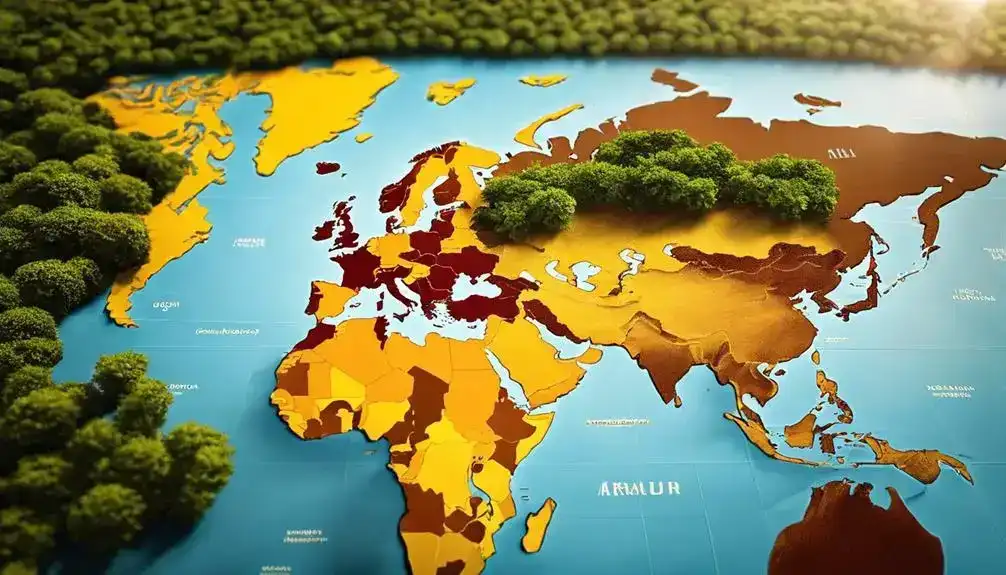
Arabica coffee has significantly impacted the globe in various ways.
Do you know who the titans of Arabica coffee production are?
Have you ever tasted the world through the flavorful cup of Arabica coffee?
Who Are the Titans of Arabica Coffee Production?
When considering the titans of Arabica coffee production, Brazil stands out for its sheer volume, while Colombia and Ethiopia are renowned for their unique and diverse flavor profiles.
Let’s take a closer look at why these countries play such significant roles in the world of Arabica coffee.
| Why Is Brazil Considered the Arabica Giant? | How Do Colombia and Ethiopia Contribute Diverse Tastes to Arabica? |
|---|---|
| Brazil produces a massive amount of Arabica coffee, making it a dominant force in the industry. | Colombia and Ethiopia bring distinct and diverse flavors to Arabica coffee due to their unique growing conditions and processing methods. |
| The sheer size of Brazil’s coffee plantations and its focus on Arabica contribute significantly to its titan status. | Colombia’s high-altitude farms and Ethiopia’s rich coffee history add depth and variety to the world of Arabica. |
| Brazilian Arabica is often characterized by its nutty and chocolatey notes, reflecting the country’s vast production and expertise. | Colombia’s Arabica is celebrated for its bright acidity and fruity undertones, while Ethiopian Arabica showcases floral and wine-like flavors. |
Why Is Brazil Considered the Arabica Giant?
Brazil stands as the Arabica giant in the global coffee production landscape. Its dominance is attributed to various factors:
- Ideal climate conditions for Arabica cultivation
- Extensive farming techniques and infrastructure
- High-quality Arabica bean varieties
- Innovation in processing methods
- Strong government support for coffee production
Brazil’s commitment to excellence and innovation has solidified its position as a key player in the Arabica coffee industry.
How Do Colombia and Ethiopia Contribute Diverse Tastes to Arabica?
Colombia and Ethiopia bring unique flavors to the Arabica coffee world, enriching the global coffee experience with their distinct contributions.
- Colombia’s high-altitude regions create a smooth, mild taste.
- Ethiopian coffee offers fruity and floral notes.
- Both countries have rich coffee-growing histories.
- The diverse climates in these regions influence the beans’ flavors.
- Colombia and Ethiopia are renowned for their specialty Arabica coffees.
Can You Taste the World Through Arabica Coffee?
When you sip on a cup of Arabica coffee, you’re tasting the diverse flavors of different regions across the globe. Latin American Arabicas offer unique aromas, while Africa and Asia are emerging with their distinct flavors. Through Arabica coffee, you can experience a world tour of tastes in every single cup.
- Latin American Arabicas offer unique aromas
- Africa and Asia are emerging with distinct flavors
- Arabica coffee provides a taste of different regions
- Each cup is like a world tour of flavors
- The global impact of Arabica coffee is evident in its diverse tastes
What Unique Aromas Do Latin American Arabicas Offer?
Explore the myriad of unique aromas that Latin American Arabicas offer, allowing you to embark on a sensory journey through the flavors of the globe with each sip.
- Citrusy notes that brighten your palate
- Nutty undertones for a comforting richness
- Floral hints that evoke a sense of elegance
- Sweet caramel accents adding depth to the brew
- Spicy aromas that intrigue and excite your taste buds
How Are Africa and Asia Emerging in Arabica Flavors?
Emerging in Arabica flavors are the distinct profiles from Africa and Asia that contribute unique and diverse taste experiences to the world of coffee. These flavors include:
- Ethiopian Arabica with its floral and fruity notes.
- Kenyan Arabica known for its bright acidity and berry undertones.
- Indonesian Arabica offering earthy and spicy flavors.
- Vietnamese Arabica with its chocolatey and nutty hints.
- Yemeni Arabica prized for its complex and wine-like flavors.
What Art Forms Exist in Processing Arabica Coffee?
As you explore the art forms in processing Arabica coffee, consider how the beans transition from cherry to bean, highlighting the intricate methods that enhance their quality.
Discover the impact of processing on Arabica’s flavor profile, showcasing how each step contributes to the unique taste of this beloved coffee variety.
Appreciate the skilled craftsmanship involved in each stage of processing that elevates Arabica coffee to a delightful and aromatic experience.
How Are Arabica Coffee Beans Transformed from Cherry to Bean?
When it comes to transforming Arabica coffee beans from cherry to bean, there are various art forms involved. These methods have been refined over time to bring out the best flavors in your coffee.
- The Ancient Art Behind the Dry Method
- The Modern Twist of the Wet Method
- The Delicate Skill of Fermentation
- The Precise Nature of Washing
- The Careful Drying Process
What Is the Ancient Art Behind the Dry Method?
To understand the ancient art behind the dry method in processing Arabica coffee, one must delve into the intricate transformation of Arabica coffee beans from cherry to bean.
- Traditional sun-drying process
- Hand-sorting to ensure quality
- Natural fermentation for flavor development
- Careful monitoring of moisture levels
- Skilled craftsmanship in turning cherries into beans
How Does the Wet Method Put a Modern Twist on Arabica Coffee?
The wet method introduces a contemporary approach to processing Arabica coffee beans, revolutionizing the traditional techniques used in transforming cherries into beans. Through this innovative method, the coffee beans undergo a sophisticated art form, enhancing their flavor and quality.
The wet method involves:
- Immersing cherries in water
- Removing the pulp mechanically
- Fermenting the beans
- Washing them thoroughly
- Drying the beans meticulously
How Does Processing Influence Arabica’s Taste?
When it comes to Arabica coffee processing, understanding the impact on taste is crucial. Different methods, like dry and wet processing, can significantly influence the flavor profile of Arabica beans.
Take a look at the table below to explore the taste disparities between dry and wet processed Arabica coffee.
| Processing Method | Taste Influence |
|---|---|
| Dry Processing | Intense, fruity flavors with a fuller body and sweetness |
| Wet Processing | Cleaner cup profile with more pronounced acidity and complexity |
What’s the Taste Difference Between Dry vs. Wet Processed Arabica?
Understanding the taste difference between dry and wet processed Arabica coffee involves recognizing the art forms in coffee processing and how they directly influence the final flavor profile.
- Dry processing enhances fruity and wine-like flavors.
- Wet processing results in cleaner, brighter, and more acidic tastes.
- Dry processing often creates a heavier body in the coffee.
- Wet processing can lead to a more balanced and nuanced flavor.
- The processing method significantly impacts the overall taste experience.
What Diversity Exists Within Arabica Coffee Varieties?

You’ll be intrigued to discover the genetic treasures hidden within different Arabica varieties, each offering unique flavors and characteristics waiting to be explored.
Have you ever wondered about the potential of hybrid Arabica coffee plants and how they could shape the future of coffee production?
Let’s uncover the fascinating diversity that exists within Arabica coffee varieties and the exciting possibilities they hold.
What Genetic Treasures Lie Within Arabica Varieties?
You’ll be fascinated by the genetic richness found in Arabica coffee varieties. Bourbon and Typica boast unique charms, while Geisha stands out as the crown jewel of the coffee world.
Explore the diversity within Arabica through these compelling traits:
- Bourbon’s rich history and distinctive flavor profile
- Typica’s widespread cultivation and classic coffee taste
- Geisha’s delicate floral and tea-like notes
- The mesmerizing complexity of SL28
- The balanced acidity and fruity undertones of SL34
What’s the Charm of Bourbon and Typica Varieties?
The charm of Bourbon and Typica varieties lies in their unique genetic makeup, showcasing the diverse treasures hidden within Arabica coffee varieties. These varieties are renowned for their exceptional flavors and distinct characteristics.
Check out the table below to explore some key differences between Bourbon and Typica:
| Aspect | Bourbon | Typica |
|---|---|---|
| Flavor | Rich and sweet | Nutty and soft |
| Yield | Lower yield | Higher yield |
| Plant Size | Compact | Tall |
| Growing Areas | Americas | Asia |
Why Is Geisha Considered the Crown Jewel of the Coffee World?
Geisha coffee stands out as the crown jewel of the coffee world due to its exquisite flavors and unique genetic profile, further highlighting the diverse treasures found within Arabica coffee varieties.
When exploring the genetics of Arabica coffee, you’ll discover:
- Exceptional resistance to diseases
- Enhanced flavor profiles
- Adaptive qualities to different climates
- Unique cupping notes
- Potential for creating new hybrid varieties
What Future Does Arabica Coffee Have Through Hybrids?
If you’re curious about the cutting-edge science behind Arabica hybrids and which variety is anticipated to make a significant impact in the coffee world, you’re in for a treat.
Take a look at the table below to explore the exciting diversity that exists within Arabica coffee varieties!
| Cutting-Edge Science | Next Big Thing Prediction |
|---|---|
| Hybridization techniques are revolutionizing the creation of new Arabica varieties. | Experts predict that the Ethiopian Gesha variety might be the next big trend in specialty coffee. |
What Cutting-Edge Science Is Involved in Arabica Hybrids?
Exploring the cutting-edge science involved in Arabica hybrids reveals the vast diversity within Arabica coffee varieties and the promising future that hybrids hold for this beloved coffee species.
- Hybridization techniques enhance disease resistance
- Genetic modification boosts yield and quality
- Climate-resilient traits are being developed
- Flavor profiles are being tailored to diverse preferences
- Sustainable farming practices are integrated for environmental preservation
Which Arabica Variety Is Predicted to Be Next Big Thing?
Amidst the diverse array of Arabica coffee varieties, one particular variety is gaining attention as the next big thing in the world of coffee.
- Excelsa: Known for its unique fruity notes.
- Geisha: Renowned for its floral and tea-like qualities.
- SL28: With a vibrant acidity and fruity flavors.
- Pacamara: A hybrid of Pacas and Maragogipe, offering a rich, complex taste.
- Bourbon: Loved for its sweet and smooth profile.
Arabica vs. Robusta: What Sets Them Apart?

When comparing Arabica and Robusta coffee, you’ll notice that Arabica triumphs in the flavor department, offering a more nuanced and complex taste profile.
In terms of caffeine content, Robusta takes the lead with nearly double the caffeine found in Arabica beans.
These distinctions between Arabica and Robusta contribute significantly to the varied coffee experiences you encounter.
What Flavor Battle Does Arabica Win Over Robusta?
When it comes to the flavor battle between Arabica and Robusta coffee, Arabica emerges as the clear winner due to its complex and varied taste profiles.
While Arabica is often described as having a smoother, sweeter, and more aromatic flavor, Robusta is known for its stronger, harsher, and more bitter taste.
This contrast in flavors is what sets Arabica apart as the connoisseur’s choice over Robusta.
| Arabica | Robusta |
|---|---|
| Smoother, Sweeter, and More Aromatic | Stronger, Harsher, and More Bitter |
Why Is Arabica the Connoisseur’s Choice?
Arabica coffee stands out as the connoisseur’s choice due to its unmatched flavor profile and superior quality compared to Robusta. Arabica wins the flavor battle over Robusta with:
- Complex and nuanced taste notes
- Delicate acidity that enhances the overall experience
- Floral and fruity undertones that add depth
- Smooth and velvety texture on the palate
- Subtle sweetness that lingers pleasantly after each sip
How Does Robusta Present an Unlikely Challenge?
Robusta, on the other hand, presents an unlikely challenge to Arabica due to its distinctly bold and bitter flavor profile that sets it apart from its more refined counterpart.
- Higher Caffeine Content: Robusta contains almost double the caffeine of Arabica.
- Robust and Earthy Notes: Its flavor profile includes earthy and nutty undertones.
- Resistance to Pests: Robusta plants are more resistant to diseases and pests.
- Lower Acidity: Robusta beans have lower acidity levels compared to Arabica.
- Bitter Aftertaste: Robusta often leaves a bitter aftertaste on the palate.
How Does the Caffeine Content Compare Between Arabica and Robusta?
Comparatively, Arabica coffee generally contains less caffeine than Robusta coffee.
While Arabica is favored for its smoother flavor profile and aromatic qualities, Robusta stands out with its higher caffeine content.
The caffeine disparity between these two popular coffee varieties can be quite significant, impacting not only the taste but also the overall experience of the brew.
Below is a comparison table showcasing the caffeine content variance between Arabica and Robusta coffee beans:
| Coffee Type | Caffeine Content (per 8 oz cup) |
|---|---|
| Arabica | 70-140 mg |
| Robusta | 150-200 mg |
As you explore the world of coffee, understanding these differences can help you choose the perfect brew to suit your taste preferences and caffeine needs.
What Environmental Story Does Arabica Coffee Tell?
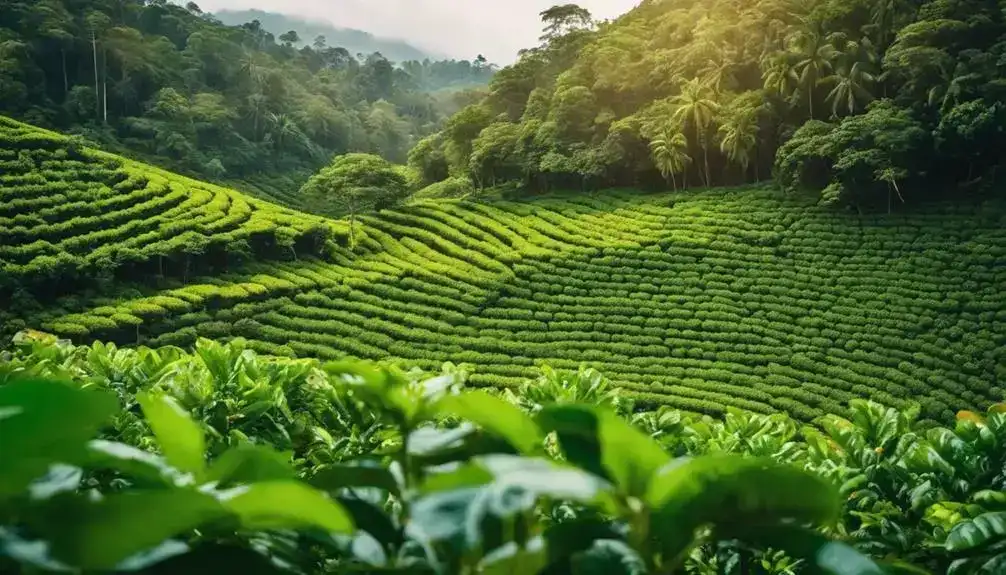
Arabica coffee tells an important environmental story due to its susceptibility to climate change and deforestation. By facing these challenges, Arabica coffee is pushing for more sustainable farming practices and eco-friendly initiatives.
This shift towards a greener coffee future showcases Arabica’s commitment to environmental stewardship.
What Environmental Dilemma Faces Arabica Coffee?
Climate change presents a significant challenge to Arabica coffee production, impacting the delicate ecosystems where it thrives.
To tackle this issue, sustainable practices are being increasingly adopted by Arabica farmers to mitigate environmental harm and ensure the longevity of this beloved coffee variety.
Below is a table outlining the effects of climate change on Arabica and the sustainable practices being implemented in Arabica farming:
| Climate Change Effects on Arabica | Sustainable Practices in Arabica Farming |
|---|---|
| Rising temperatures and unpredictable rainfall patterns | Organic farming methods to reduce chemical inputs |
| Increased pests and diseases due to changing climate conditions | Agroforestry techniques to provide shade and biodiversity |
| Loss of suitable growing regions leading to decreased production | Water conservation strategies such as drip irrigation |
| Impact on coffee quality and flavor profiles | Carbon offset programs to reduce greenhouse gas emissions |
How Is Climate Change Affecting Arabica?
In the face of changing environmental conditions, Arabica coffee is encountering significant challenges due to climate fluctuations.
The rising temperatures and unpredictable weather patterns brought about by climate change are negatively impacting Arabica coffee production. Prolonged droughts, increased pest infestations, and shifting growing conditions threaten the sustainability of Arabica coffee farms.
To address these issues, innovative solutions and sustainable practices are crucial for the future of Arabica cultivation.
| Climate Change Impact | Effects |
|---|---|
| Rising Temperatures | Stress on coffee plants |
| Unpredictable Weather Patterns | Inconsistent harvests |
| Prolonged Droughts | Water scarcity |
| Increased Pest Infestations | Crop damage |
What Sustainable Practices Are Being Implemented in Arabica Farming?
Facing the challenges posed by climate change, sustainable practices are being implemented in Arabica farming to ensure the resilience and longevity of coffee production.
- Implementation of agroforestry techniques
- Water conservation practices
- Organic farming methods
- Biodiversity preservation efforts
- Carbon footprint reduction initiatives
How Is Arabica Leading the Way to a Greener Coffee Future?
When it comes to leading the way to a greener coffee future, Arabica coffee has some compelling environmental practices. You’ll discover revolutionary farming methods and certifications that ensure sustainable Arabica production. Here are some key points to consider:
- Implementation of shade-grown cultivation
- Employment of organic farming techniques
- Promotion of biodiversity on coffee farms
- Support for fair trade practices
- Adoption of water conservation measures
What Revolutionary Practices Are Transforming Arabica Farming?
Revolutionary practices in Arabica farming are reshaping the landscape of sustainable coffee production, paving the way for a greener future in the industry.
- Introduction of precision farming techniques
- Implementation of vertical farming methods
- Integration of IoT technology for monitoring crops
- Adoption of regenerative agriculture practices
- Utilization of sustainable water management systems
How Are Certifications Guarding Sustainable Arabica?
Certifications play a crucial role in safeguarding sustainable Arabica coffee production, highlighting the environmental commitment and quality standards upheld by coffee farmers and producers.
- Certification programs ensure ethical labor practices
- Promote biodiversity conservation
- Encourage sustainable farming techniques
- Support fair trade principles
- Verify organic cultivation methods
How Does Arabica Shine in Specialty Coffee?
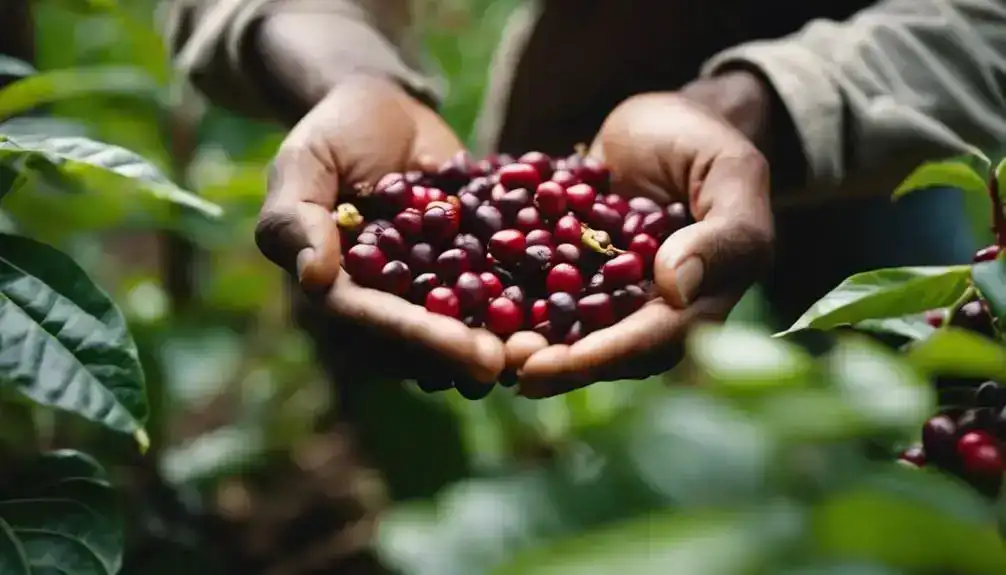
When it comes to specialty coffee, Arabica shines brightly.
The renaissance of single-origin Arabica coffees is captivating coffee enthusiasts worldwide.
Understanding the intricate science and art behind Arabica coffee blends is key to appreciating its exceptional quality.
What Renaissance Is Happening with Single-Origin Arabica Coffees?
You’re embarking on a journey to discover the ultimate single-origin Arabica experience. Each sip reveals the intricate influence of terroir on the soul of Arabica coffee.
Explore how Arabica shines in specialty coffee through:
- The unique flavor profiles of distinct regions
- The emphasis on sustainable farming practices
- The meticulous processing methods
- The direct relationships with growers
- The celebration of coffee diversity
What Quest Is Underway for the Ultimate Single-Origin Arabica Experience?
Embarking on a quest for the ultimate single-origin Arabica experience unveils a renaissance in the specialty coffee world, where Arabica’s unique flavors and complexities shine brightly.
Explore the following to enhance your coffee journey:
- Direct Relationship with Farmers: Foster connections for a deeper coffee experience.
- Microlot Exploration: Discover exceptional small-batch Arabica gems.
- Processing Innovations: Experience new methods that elevate the coffee’s profile.
- Geographic Diversity: Delight in the varied terroirs influencing Arabica beans.
- Exclusive Tasting Events: Engage in curated experiences to savor Arabica’s nuances.
How Does Terroir Shape the Soul of Arabica Coffee?
Terroir plays a crucial role in shaping the soul of Arabica coffee, defining its unique flavors and characteristics in the world of specialty coffee.
- Arabica beans absorb nuances from the soil and climate.
- Altitude influences acidity and sweetness.
- Different regions produce diverse tasting notes.
- Soil composition affects the body and mouthfeel.
- Climate variations contribute to the complexity of each cup.
What’s the Science and Art Behind Arabica Coffee Blends?
When it comes to Arabica coffee blends, you may wonder how this bean masters the art and science of blending. Explore how Arabica excels in creating harmonious and complex flavor profiles, making it a sought-after choice for specialty coffee enthusiasts. Discover the pivotal role Arabica plays in crafting rich and balanced espresso blends.
| How Is Arabica Mastering the Blend? | What Role Does Arabica Play in Espresso Blends? | |
|---|---|---|
| – Carefully balancing flavors and aromas. – Utilizing precise roasting techniques. – Sourcing beans from diverse regions. – Experimenting with different processing methods. – Emphasizing sustainability practices. | – Bright acidity – Floral and fruity notes – Smooth mouthfeel – Balanced sweetness – Delicate aromas |
How Is Arabica Mastering the Blend?
Mastering the blend, Arabica coffee showcases its excellence in specialty coffee through a harmonious fusion of science and artistry.
Arabica excels in creating exceptional blends by carefully balancing flavors and aromas, utilizing precise roasting techniques, sourcing beans from diverse regions, experimenting with different processing methods, and emphasizing sustainability practices.
This meticulous approach results in Arabica’s ability to consistently deliver complex and delightful coffee blends.
What Role Does Arabica Play in Espresso Blends?
Arabica coffee shines in espresso blends by infusing a rich depth of flavor and a nuanced complexity that elevates the overall coffee experience. When blended with other beans, Arabica contributes:
- Bright acidity
- Floral and fruity notes
- Smooth mouthfeel
- Balanced sweetness
- Delicate aromas
These characteristics work harmoniously to create an exceptional espresso that delights the senses and leaves a lasting impression.
How Can You Master Brewing Arabica Coffee?
Want to brew the perfect cup of Arabica coffee? Discover the secret to unlocking the bean’s full potential with different Arabica coffee recipes.
Let’s explore how you can master the art of brewing this exquisite coffee bean.
What’s the Secret to Brewing the Perfect Arabica Cup?
When brewing Arabica coffee, mastering the art is key to achieving a perfect cup. You can start by understanding how crucial grinding is to unlock the full flavor potential of Arabica beans. Take a look at the table below to explore different grind sizes and their impact on your Arabica brew.
| Grind Size | Brewing Method | Flavor Outcome |
|---|---|---|
| Coarse | French Press | Bold and Rich |
| Medium | Drip Coffee Maker | Balanced |
| Fine | Espresso Machine | Intense and Strong |
How Crucial Is Grinding for Arabica Coffee Flavor?
Grinding plays a crucial role in enhancing the flavor of your Arabica coffee brew. The aroma, taste, and overall experience are greatly influenced by the grind size. To master the perfect cup, consider the following grind sizes:
| Grind Size | Description | Best Used With |
|---|---|---|
| Coarse | Chunky particles | French Press |
| Medium | Gritty consistency | Drip Coffee Maker |
| Fine | Smooth like flour | Espresso Machine |
What Arabica Coffee Recipes Unlock the Bean’s Potential?
To truly unlock the potential of Arabica coffee, you’ll want to explore various brewing techniques and perfect food pairings. Here are some key points to consider:
- Experiment with traditional methods like pour-over or French press.
- Try trendy options such as cold brew or espresso-based drinks.
- Discover which foods complement the flavors of Arabica coffee best.
- Enhance your brewing skills by mastering the art of latte art.
- Don’t forget to adjust the grind size and water temperature for optimal extraction.
What Brewing Techniques Range from Traditional to Trendy for Arabica?
To unlock the full potential of Arabica coffee beans, mastering brewing techniques that range from traditional to trendy is essential. Explore these innovative methods for brewing Arabica coffee:
- Cold Brew: Extracts flavors slowly without heat.
- Pour-Over: Delivers a clean and bright cup.
- AeroPress: Creates a rich and smooth brew.
- French Press: Produces a full-bodied and robust coffee.
- Espresso: Intensifies the bean’s flavors in a concentrated shot.
What Are the Best Foods to Pair with Your Arabica Coffee?
Pairing your Arabica coffee with the right foods can enhance your overall coffee experience and bring out the best flavors in both the coffee and the dishes. When brewing Arabica coffee, consider these innovative food pairings:
- A flaky almond croissant
- Dark chocolate truffles
- Fresh berries with whipped cream
- Spiced cinnamon buns
- Savory avocado toast
What’s the Cultural and Economic Saga of Arabica Coffee?

Explore the untold historical journey of Arabica coffee and uncover its cultural significance.
Discover the economic power that Arabica coffee holds in the global market and its impact on various economies.
Immerse yourself in the rich cultural and economic saga of Arabica coffee to gain a deeper understanding of its influence on societies worldwide.
How Has Arabica’s Historical Journey Been a Story Untold?
Have you ever thought about the remarkable journey Arabica coffee has taken through history? Discover the untold cultural and economic saga behind this beloved brew that has shaped societies and economies.
Unravel the captivating story of Arabica coffee’s origins and its influence on the social fabric of communities worldwide.
- Uncover the secrets of Arabica’s roots and how they intertwine with human history.
- Explore how Arabica coffee has become a central part of social gatherings and rituals.
- Understand the economic significance of Arabica coffee in global trade.
- Learn about the cultural impact of Arabica on different societies.
- Appreciate how Arabica coffee has transcended mere beverage status to symbolize connection and hospitality.
What Adventure Does Tracing Arabica’s Roots Reveal?
Tracing Arabica’s roots reveals a captivating saga of cultural exchange and economic prosperity intertwined with the untold stories of its historical journey. The adventure of uncovering Arabica’s lineage presents:
- Fusion of Ethiopian and Yemeni coffee traditions.
- Spread through Ottoman Empire trade routes.
- European cultivation during the colonial era.
- Transformation into a global commodity.
- Influence on modern coffee culture worldwide.
How Has Arabica Coffee Become the Heart of Social Life?
Uncover the captivating ways in which Arabica coffee weaves through the fabric of social life, enriching cultural connections and fostering economic vitality across diverse communities.
Arabica coffee has embedded itself in cultures worldwide, serving as a symbol of hospitality, tradition, and community gatherings. Its presence resonates in cafes, homes, and workplaces, creating a shared experience that transcends borders and unites individuals from all walks of life.
- Symbol of Hospitality
- Tradition and Ritual
- Community Gatherings
- Shared Experiences
- Cultural Unifier
What Economic Power Does Arabica Coffee Hold?
When considering the economic power of Arabica coffee, you may be surprised by its significant impact on global markets. Have you ever thought about the new era emerging in ethical Arabica coffee production? It’s time to explore these intriguing facets further through the following table:
| Economic Impact | Ethical Production |
|---|---|
| Substantial contribution to GDP | Fair trade practices |
| Employment opportunities | Sustainable farming methods |
| Market volatility effects | Environmental conservation |
| Price trends | Social responsibility |
| Global demand | Quality standards |
How Significant Is the Economic Impact of Arabica Coffee?
Exploring the economic impact of Arabica coffee reveals its significant role in shaping both cultural practices and global markets.
Arabica coffee contributes substantially to the economy through production, exportation, and job creation.
Its high demand and premium pricing drive economic growth in coffee-producing regions, making it a key player in the global market. The table below illustrates the economic significance of Arabica coffee.
| Economic Impact | Description |
|---|---|
| Production | Major source of income |
| Exportation | Boosts international trade |
| Job Creation | Employment opportunities |
| Market Influence | Premium pricing |
| Economic Growth | Stimulates local economies |
What New Dawn Is Rising with Ethical Arabica Coffee Production?
Ethical Arabica coffee production is ushering in a new era of sustainability and responsibility in the coffee industry.
- Direct Impact: Better wages for workers.
- Environmental Stewardship: Sustainable farming practices.
- Community Empowerment: Support for local communities.
- Quality Assurance: Higher standards in coffee production.
- Global Awareness: Promoting ethical sourcing from Arabica coffee plantations.
What Does the Future Hold for Arabica Coffee?
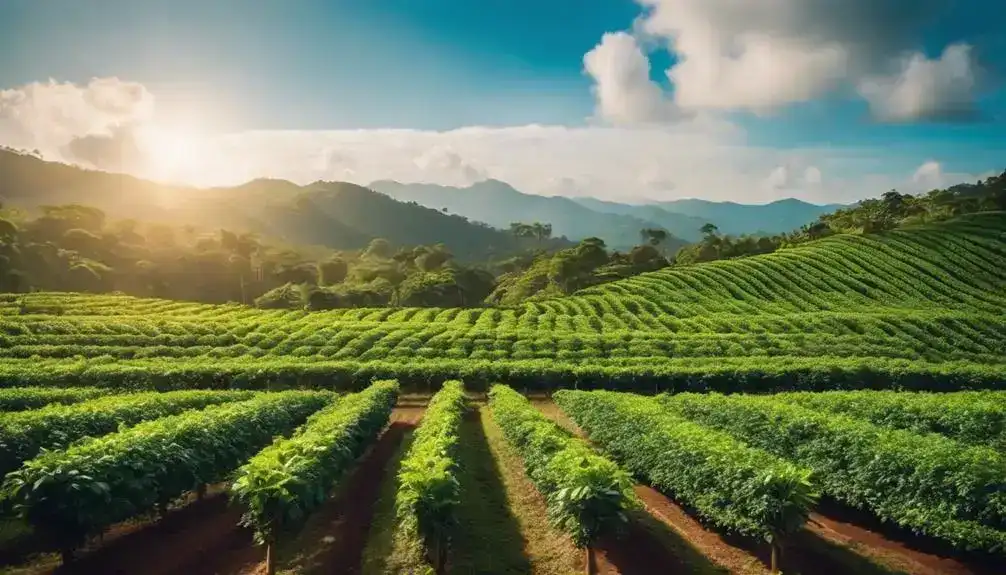
You may be curious about the exciting innovations shaping the future of Arabica coffee.
From sustainable farming practices to advanced processing techniques, the coffee industry is constantly evolving.
These advancements aren’t only enhancing coffee quality but also ensuring a more sustainable future for Arabica coffee production.
What Innovations Are Pioneering the Future of Arabica Coffee?
As we look ahead to the future of Arabica coffee, innovative technologies and sustainable practices are paving the way for a more promising and environmentally conscious industry.
The world of Arabica coffee is experiencing a revolution, with cutting-edge advancements reshaping how coffee is grown, harvested, and enjoyed.
Check out the table below to see some of the exciting innovations that are shaping the future of Arabica coffee:
| Innovation | Description | Impact |
|---|---|---|
| Smart Farming | Utilizing IoT sensors for real-time crop monitoring | Increased yield and resource efficiency |
| Blockchain Traceability | Tracking coffee beans from farm to cup | Ensuring transparency and fair trade practices |
| Precision Roasting | Advanced roasting techniques for flavor optimization | Consistent high-quality coffee experience |
With these remarkable advancements, the future of Arabica coffee looks brighter than ever, promising both exceptional quality and sustainability.
Conclusion
Now that you’ve uncovered the fascinating world of Arabica coffee, why not put your newfound knowledge to the test?
Imagine waking up to the rich aroma of freshly brewed Arabica coffee from a family-owned farm in Colombia. By supporting sustainable coffee practices, you not only savor the exquisite taste but also contribute to the livelihood of local farmers.
Embrace the magic of Arabica coffee and make each cup a journey of discovery. Cheers to your next coffee adventure!

